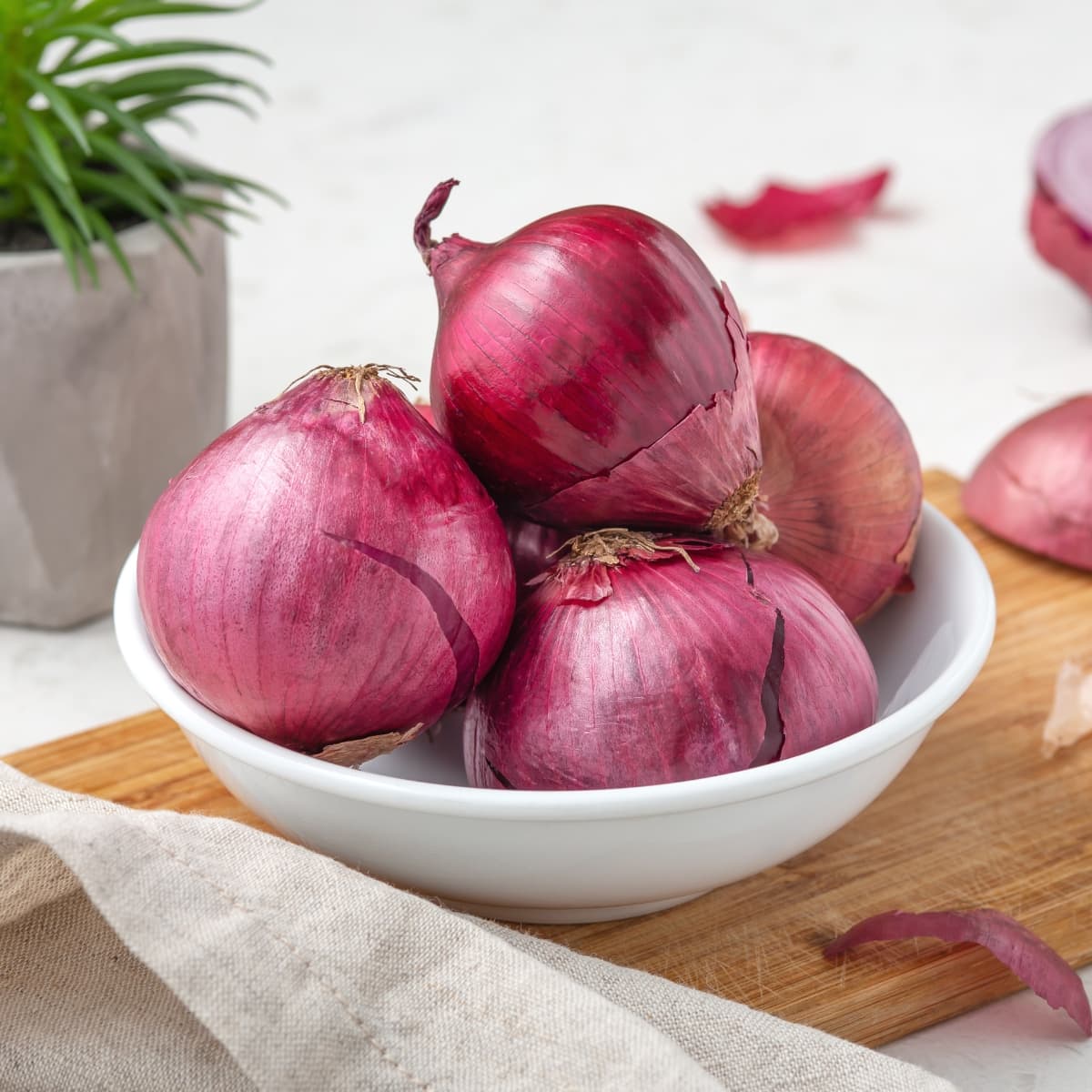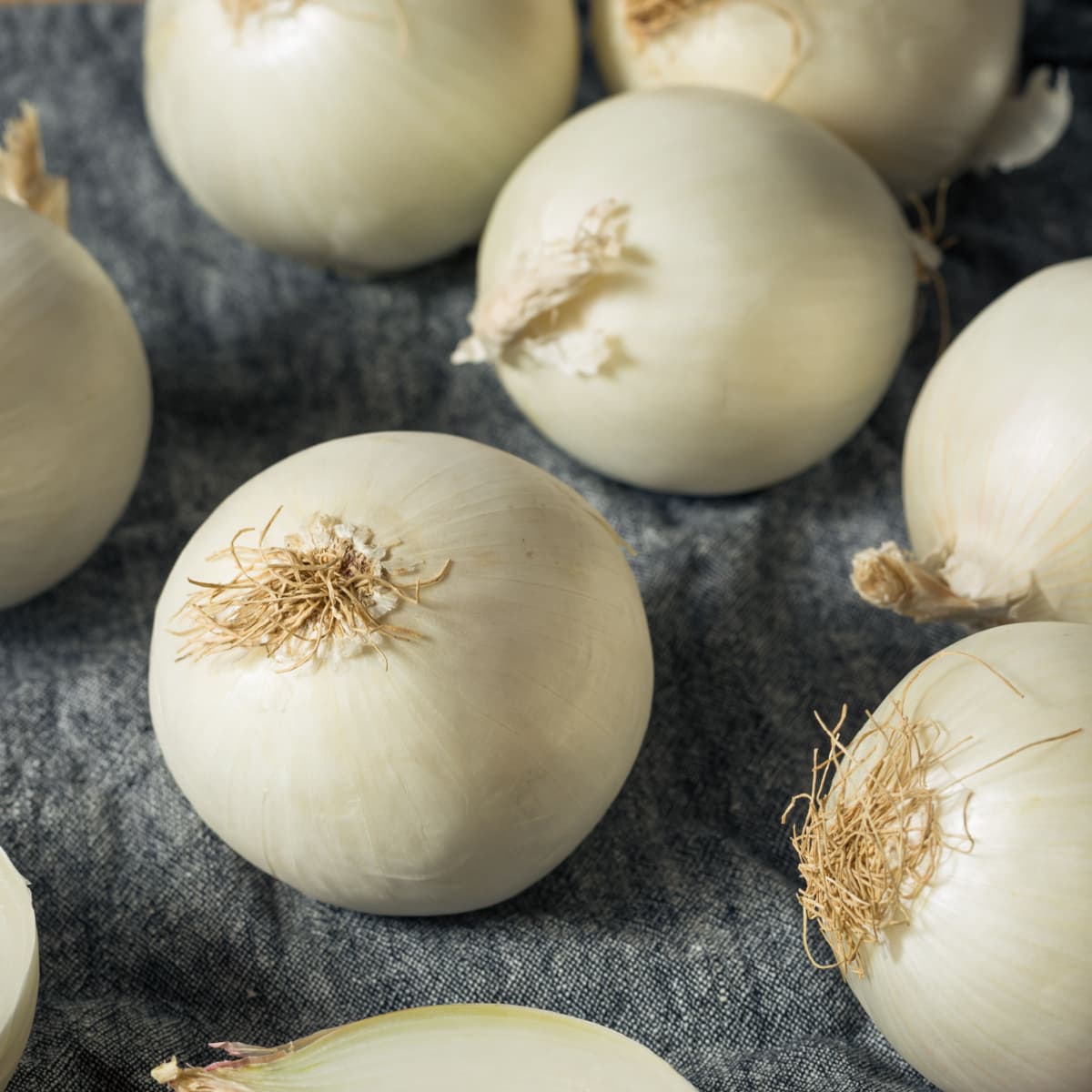If you’re out of shallots, you’re in luck! The top shallot substitutes include leeks, onions, chives, and garlic.
Sweet and delicate, shallots are unique, so finding the right replacement in your recipes is key.

Before you reach for one of these alternatives, consider your dish. You want the pungency, sweetness, and sharpness of the shallot substitute to be comparable.
So, let’s peel back the layers to find the perfect match. Also, I’ll touch on what shallots are so you can find the right substitute.
What Is a Shallot?
A shallot (Allium cepa aggregatum) is a type of perennial onion. They have a pale, purplish-brown color with multiple cloves clustered together.
Known for their mild and sweet flavor, shallots are part of the allium family. This group also includes garlic, onions, and leeks.
Many describe them as a cross between garlic and onion. Given they’re in the same family, it’s not too surprising.
They’re smaller and more delicate than onions, though.
When a recipe calls for a mild onion flavor, these gems are the ideal choice. Raw or cooked, shallots are very versatile. Dressings, salads, sauces, soups, and pasta are just the start.
There are tons of shallot recipes to include in your everyday cooking.
Best Shallot Substitutes
Out of shallots? Not a problem!
With these substitutes, you can flavor your dishes just right. Here are the best shallot alternatives to use.

1. Leeks
If you want a replacement with the closest flavor, go with leeks. These alliums are a little milder with a delicate onion flavor.
Remember that you only want to use the white and light green parts. The dark green tops are fibrous and woody.
But you don’t have to let them go to waste! Save them for something else, like making vegetable stock.
You can use equal part leeks as a substitute. For a stronger flavor, use more.
Raw or cooked, they’re a fine replacement either way. They’ll cook down faster, though. So add them a little later than you would shallots.
Substitute a 1:1 ratio of leeks to shallots.

2. Yellow Onions
Yellow onions are your everyday type of allium. Many home cooks keep these universal bulbs on hand for a variety of recipes.
They’re less pungent than white onions with a sweeter flavor.
Compared to shallots, however, they’re more potent. They have a bigger onion flavor, and they don’t cook down as quickly.
So use half as much yellow onion as you would shallots. You can always add more if you find it’s not enough.
Also, you can use them either raw or cooked. For the latter, cook them longer so they break down fully.
Substitute 1/2 cup yellow onion for 1 cup shallots.

3. Red Onions
Another onion variety that works is red onion. Like shallots, they have a purplish color that adds a pop to your dish.
They’re less delicate and sharper in pungency. But they do have a wonderful, sweet flavor.
You can use them raw or cooked. Just remember they’re more potent.
I recommend slicing them thin when using them raw. Big bits of chopped red onion may give you a bigger flavor than you wanted.
Substitute 1/4 cup red onions for 1 cup shallots.

4. Chives
Substituting with chives is a great choice when you don’t have shallots on hand.
These onion relatives aren’t potent at all. Rather, chives are mild with a fresh onion and garlic flavor. So they’re closer to shallots than other pungent alternatives.
Many people confuse them with green onions. But they’re not the same thing. These herbs are much thinner and lack a green bulb.
They’re common as a garnish, making them a terrific addition raw. Use them to freshen up potato salad or an omelet.
If your recipe calls for cooking, add them at the very end. Gently cooking chives will help preserve their delicate nature.
Substitute a 1:1 ratio of chives to shallots.

5. Scallions (Green Onions)
For a less potent swap, go with scallions.
Also referred to as green onions, scallions have a fresh onion flavor. So you get a similar taste minus the pungency.
Use them as a substitute raw or cooked. They’re fantastic as a garnish and won’t overpower a dish. Scallions are also excellent in soups, pancakes, stir-fries, and more.
Keep in mind, they don’t have the garlicky quality you get with shallots. So, you can always include a garlic clove or garlic powder.
Substitute 1:1 scallions to shallots.

6. Garlic
Are you all out of onions? Use garlic instead. As a member of the Allium family, it’s a viable substitute.
It won’t have the same onion flavor, but it has a pungent kick.
If you’re using it raw, garlic will pack some punch. So it’s not ideal for fresh dishes that lack cooking.
When you roast or cook garlic, it takes on a sweeter flavor and mellows out. So consider this option for a less intense flavor.
Keep in mind, it won’t taste the same. But it will add a nice flavor and aroma.
Substitute 1 garlic clove for 1 shallot.

7. Garlic Scapes
Like garlic cloves, you can use garlic scapes, too. These are the tender green stems that grow on hardneck garlic.
They aren’t as common as shallots. Garlic scapes taste garlicky, but less so than cloves. So they’re a great choice if you’re looking for a mild garlic flavor.
Plus, they add a lovely pop of color!
Raw or cooked, garlic scapes can be a nice addition. I recommend using equal parts. You can also add more for a bigger garlicky kick.
Substitute a 1:1 ratio of garlic scapes to shallot.

8. White Onions
White onions are sharp and pungent. They’re not mild nor delicate like shallots. So using these instead will come across in the dish. But it’s not necessarily a bad thing!
When cooked, white onions are a nice replacement. Soups and stews are excellent meals for them.
They need to cook longer than shallots. So add them at the beginning of the dish.
You can use them raw, but I don’t recommend it. You may find them too sharp and overpowering.
Therefore, white onions are not ideal for raw dishes.
Substitute 1/4 cup of white onions for 1 cup of shallots.

9. Pearl Onions
Pearl onions are another prime substitute you can reach for. They’re mild and sweet, even sweeter than shallots.
Unlike white or yellow onions, they’re far less pungent. So, using them raw isn’t likely to overpower the dish.
Pickled, sauteed, roasted, or glazed, you can cook them in many ways. They can have white, red, or gold papery skin.
The red variety is milder. So those are the ones I recommend using raw. Otherwise, white is better for cooking.
Note that peeling these tiny onions is somewhat tricky. The papery skin sticks more to the bulb than other onions.
Blanching them for 1 minute and using a cold water bath helps. You can slice off the root end and pop them out of their papery skin.
Substitute a 1:1 ratio of pearl onions to shallots.

10. Cipollini Onions
If a sweeter flavor is what you’re after, try cipollini onions. These smaller, saucer-shaped onions are very sweet with a hint of onion.
They have more sugar than your typical white or yellow onion. Keep this in mind when using them instead of shallots.
Like other varieties, you can use them cooked or raw. They’re especially good caramelized or roasted.
Try them in pasta, omelets, or stews.
Substitute a 1:1 ratio of cipollini onions to shallots.
Tips for Working with Shallot Substitutes
Shallots are a delicate type of onion. They have a sweet flavor, and they cook down readily.
For any substitute, consider the overall sweetness and pungency. When in doubt, less is more.
You can always add more of a substitute to your dish. But trying to compensate for adding too much is a lot harder.
Some recipes may give exact measurements. Others may merely call for a whole shallot.
Use this general guide to find the right ratio:
- Small shallot. About 2 tablespoons chopped.
- Medium shallot. About 1/4 cup chopped.
- Large shallot. About 1/2 cup chopped.
Also, keep in mind that cooked versus raw has different results. You know what I mean if you’ve ever bit into raw white onion!
Cooking will mellow out pungent onions. So skip the potent allium varieties when your dish calls for raw shallots.











